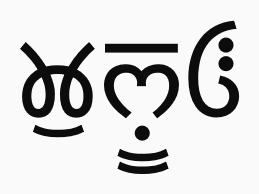
The Indo-Aryan languages are a branch of the Indo-Iranian languages in the Indo-European language family. As of the early 21st century, they have more than 800 million speakers, primarily concentrated in India, Pakistan, Sri Lanka, Bangladesh, Nepal and Maldives. Moreover, apart from the Indian subcontinent, large immigrant and expatriate Indo-Aryan–speaking communities live in Northwestern Europe, Western Asia, North America, the Caribbean, Southeast Africa, Polynesia and Australia, along with several million speakers of Romani languages primarily concentrated in Southeastern Europe. There are over 200 known Indo-Aryan languages.
Devanagari is an Indic script used for many Indo-Aryan languages of North India and Nepal, including Hindi, Marathi and Nepali, which was the script used to write Classical Sanskrit. There are several somewhat similar methods of transliteration from Devanagari to the Roman script, including the influential and lossless IAST notation. Romanized Devanagari is also called Romanagari.
The International Alphabet of Sanskrit Transliteration (IAST) is a transliteration scheme that allows the lossless romanisation of Indic scripts as employed by Sanskrit and related Indic languages. It is based on a scheme that emerged during the 19th century from suggestions by Charles Trevelyan, William Jones, Monier Monier-Williams and other scholars, and formalised by the Transliteration Committee of the Geneva Oriental Congress, in September 1894. IAST makes it possible for the reader to read the Indic text unambiguously, exactly as if it were in the original Indic script. It is this faithfulness to the original scripts that accounts for its continuing popularity amongst scholars.
Madras Bashai was the variety of the Tamil language spoken by native people in the city of Madras in the Indian state of Tamil Nadu. It was sometimes considered a pidgin, as its vocabulary was heavily influenced by Hindustani, Indian English, Telugu, Malayalam, and Burmese; it is not mutually intelligible with any of those except for Tamil, to a certain extent.
The nuqta, is a diacritic mark that was introduced in Devanagari and some other Indic scripts to represent sounds not present in the original scripts. It takes the form of a dot placed below a character. This idea is inspired from the Arabic script; for example, there are some letters in Urdu that share the same basic shape but differ in the placement of dots(s) or nuqta(s) in the Perso-Arabic script: the letter ع ayn, with the addition of a nuqta on top, becomes the letter غ g͟hayn.

Kullui is a Western Pahari language spoken in the Kullu District of the Indian state of Himachal Pradesh.
Indic Computing means "computing in Indic", i.e., Indian Scripts and Languages. It involves developing software in Indic Scripts/languages, Input methods, Localization of computer applications, web development, Database Management, Spell checkers, Speech to Text and Text to Speech applications and OCR in Indian languages.
The phoneme inventory of the Marathi language is similar to that of many other Indo-Aryan languages. An IPA chart of all contrastive sounds in Marathi is provided below.

Mandeali is a language spoken in northern India, predominantly in the Mandi district of Himachal Pradesh by the people of the Mandi Valley and particularly in the major city of Mandi. Other spellings for the name are Mandiyali and Mandiali. UNESCO reports it is one of the highly endangered languages of India. Speakers of the dialect have decreased by 21% from 1961 to 2001.

Google IME, also known as Google Input Tools, is a set of input method editors by Google for 22 languages, including Amharic, Arabic, Bengali, Chinese, Greek, Gujarati, Hindi, Japanese, Kannada, Malayalam, Marathi, Nepali, Persian, Punjabi, Russian, Sanskrit, Serbian, Tamil, Telugu, Tigrinya, and Urdu. It is a virtual keyboard that allows users to type in their local language text directly in any application without the hassle of copying and pasting.

Sirmauri is a Western Pahari language spoken in the Sirmaur district in the northern Indian state of Himachal Pradesh. Its two main varieties are Dharthi and Giripari.

Hinduri is a Western Pahari language of northern India. It was classified as a dialect under the Kiunthali Group

Bhadarwahi is an Indo-Aryan language of the Western Pahari group spoken in the Bhaderwah region of Indian administered Jammu and Kashmir.
Bhariati is an unclassified Indo-Aryan language spoken in the Patalkot Valley of Madhya Pradesh in central India.

Bilaspuri, or Kahluri (Takri:𑚊𑚩𑚥𑚱𑚤𑚯) is a language spoken in northern India, predominantly in the Bilaspur district of Himachal Pradesh. It is associated with the people of the former princely state of Bilaspur in the Panjab Hills.
Chambeali is a language spoken in the Chamba district of Himachal Pradesh.

Pangwali is a Western Pahari language of Himachal Pradesh, India. It is spoken in the Pangi Tehsil of Chamba district, and is threatened to go extinct. Pangwali is natively written in the Takri script, but Devanagari is used as well. It is very similar to the Padderi language of Padder, J&K.

Churahi is a Western Pahari language of Himachal Pradesh, India. It is spoken in the Chaurah and Saluni tehsils of Chamba district, and is considered vulnerable.

Gaddi is an Indo-Aryan language of India. It is spoken by the Gaddi people primarily in Bharmour Tehsil of Chamba district in Himachal Pradesh. It is also spoken in neighbouring parts of Jammu, with Gaddi villages found in Udhampur, Kathua and Doda districts.
The Chinali–Lahul languages, or Chinali–Lahuli, are a pair of closely related languages with uncertain relationship within the Indo-Aryan languages. They are,









